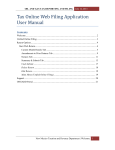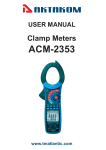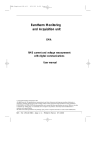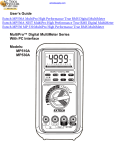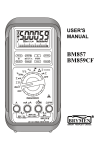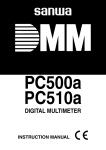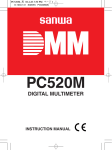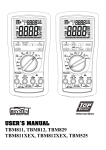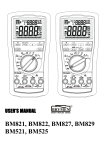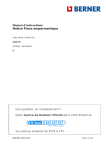Download Model UT209 OPERATING MANUAL
Transcript
Model UT209 OPERATING MANUAL Model UT209: OPERATING MANUAL Table of Contents Title Page Overview Unpacking Inspection Safety Information Rules For Safe Operation International Electrical Symbols The Meter Structure Functional Buttons The Effectiveness of Functional Buttons Display Symbols Measurement Operation A. DC/AC Voltage Measurement B. Measuring Resistance C. Testing Diodes D. Testing for Continuity E. Frequency Measurement F. DC Current Measurement 3 4 5 6 9 10 11 13 14 17 17 19 21 23 25 27 1 Model UT209: OPERATING MANUAL Title Page G. AC Current Measurement Sleep Mode Specifications A. General Specifications B. Environmental Requirements Accuracy Specifications A. DC Voltage B. AC Voltage C. Resistance D. Diode Test E. Continuity Test F. Frequency G. DC Current H. AC Current Maintenance A. General Service B. Replacing the Battery 30 32 33 33 34 35 35 36 37 38 38 39 40 40 41 41 42 2 Model UT209: OPERATING MANUAL Overview This Operating Manual covers information on safety and cautions. Please read the relevant information carefully and observe all the Warnings and Notes strictly. Warning To avoid electric shock or personal injury, read the “Safety Information” and “Rules for Safe Operation” carefully before using the Meter. Digital Clamp Multimeter Model UT209 (hereafter referred to as “the Meter”) are 3 3/4 digits with steady operations, fashionable structure and highly reliable measuring instrument. The Meter uses large scale of integrated circuit with double integrated A/D converter as its core and has full range overload protection. The Meter can measure AC/DC Voltage, AC/DC Current, Frequency, Resistance, Diodes, Continuity and etc. 3 Model UT209: OPERATING MANUAL Unpacking Inspection Open the package case and take out the Meter. Check the following items carefully to see any missing or damaged part: Item Description Qty 1 2 3 4 English Operating Manual Test Lead Tool Box 9V Battery (NEDA1604A or 6LF22) 1 piece 1 pair 1 piece 1 piece In the event you find any missing or damage, please contact your dealer immediately. 4 Model UT209: OPERATING MANUAL Safety Information This Meter complies with the standards IEC61010: in pollution degree 2, overvoltage category (CAT. II 600V, CAT. III 300V) and double insulation. CAT. II: Local level, appliance, PORTABLE EQUIPMENT etc., with smaller transient overvoltages than CAT. III. CAT. III: Distribution level, fixed installation, with smaller transient overvoltages than CAT. IV Use the Meter only as specified in this operating manual, otherwise the protection provided by the Meter may be impaired. In this manual, a Warning identifies conditions and actions that pose hazards to the user, or may damage the Meter or the equipment under test. A Note identifies the information that user should pay attention to. International electrical symbols used on the Meter and in this Operating Manual are explained on page 9. 5 Model UT209: OPERATING MANUAL Rules For Safe Operation Warning To avoid possible electric shock or personal injury, and to avoid possible damage to the Meter or to the equipment under test, adhere to the following rules: Before using the Meter inspect the case. Do not use the Meter if it is damaged or the case (or part of the case) is removed. Look for cracks or missing plastic. Pay attention to the insulation around the connectors. Inspect the test leads for damaged insulation or exposed metal. Check the test leads for continuity. Replace damaged test leads with identical model number or electrical specifications before using the Meter. Do not apply more that the rated voltage, as marked on the Meter , between the terminals or between any terminal and grounding. When measurement has been completed, disconnect the connection between the test leads and the circuit under test, remove the testing leads away from the input terminals of the Meter and turn the Meter power off. The rotary switch should be placed in the right position and no any 6 Model UT209: OPERATING MANUAL changeover of range shall be made during measurement is conducted to prevent damage of the Meter. Do not carry out the measurement when the Meter’s back case and battery compartment are not closed to avoid electric shock. Do not input higher than 600V between the two Meter’s input terminal to avoid electric shock and damages to the Meter. When the Meter working at an effective voltage over 70V in DC or 33V rms in AC, special care should be taken for there is danger of electric shock. Use the proper terminals, function, and range for your measurements. Do not use or store the Meter in an environment of high temperature, humidity, explosive, inflammable and strong magnetic field. The performance of the Meter may deteriorate after dampened. When using the test leads, keep your fingers behind the finger guards. To avoid electric shock, do not touch the bare wires, connectors, unused input terminals or the circuit under testing during measurement. Disconnect circuit power and discharge all high-voltage capacitors before testing resistance, continuity and diode. Replace the battery as soon as the battery indicator appears. With a low battery, the Meter might produce false readings that can lead to electric shock and personal injury. 7 Model UT209: OPERATING MANUAL When servicing the Meter, use only the same model number or identical electrical specifications replacement parts. The internal circuit of the Meter shall not be altered at will to avoid damage of the Meter and any accident. Soft cloth and mild detergent should be used to clean the surface of the Meter when servicing. No abrasive and solvent should be used to prevent the surface of the Meter from corrosion, damage and accident. The Meter is suitable for indoor use. Turn the Meter off when it is not in use and take out the battery when not using for a long time. Constantly check the battery as it may leak when it has been using for some time, replace the battery as soon as leaking appears. A leaking battery will damage the Meter. 8 Model UT209: OPERATING MANUAL International Electrical Symbols AC (Alternating Current) DC (Direct Current) AC or DC Grounding Double Insulated Warning. Refer to the Operating Manual Deficiency of Built-In Battery Continuity Test Diode Danger of High Voltage Conforms to Standards of European Union 9 Model UT209: OPERATING MANUAL The Meter Structure (see figure 1) 1. Hand Guards: to protect user’s hand from touching the dangerous area. 2. Trigger: press the lever to open the transformer jaws. When the pressure on the lever is released, the jaws will close. 3. Functional Buttons 4. Input Terminals 5. LCD Display 6. Rotary Switch 7. Transformer Jaw: designed to pick up the AC and DC current flowing through the conductor. It could transfer current to voltage. The tested conductor must vertically go through the Jaw center. Figure 1 10 Model UT209: OPERATING MANUAL Functional Buttons Below table indicated for information about the functional button operations. Button Operation Performed SELECT Press SELECT button to select the alternate functions including V , and PMAX/PMIN Press and hold for 2 seconds to enter that function internal calibration. Press the button once to start recording of maximum peak value. Press the button again to start recording of minimum peak value. Press and hold for one second to exit PMAX/PMIN mode. Press once to turn the display backlight on. It will automatically off after around 15 seconds. HOLD Press HOLD to enter the Hold mode in any mode, the Meter beeps. Press HOLD again to exit the Hold mode to return to measurement mode, the Meter beeps. 11 Model UT209: OPERATING MANUAL Button HOLD Hz ZERO Operation Performed Turn the rotary switch or press SELECT button can also exit Hold mode. Press HOLD button for 2 seconds when turning on the Meter to display full icon. When the Meter is at V , A and A , press the button to measure frequency. But the frequency readings obtained from these ranges are only for reference, Press ZERO to display the present value as stored value and display zero. After that, all the measurement result displayed will automatically subtract the stored value. Press ZERO again to display the stored value. Press and hold ZERO to exit and back to normal operation. 12 Model UT209: OPERATING MANUAL The Effectiveness of Functional Buttons Not every functional buttons can be used on every rotary switch positions. Below table describe which functional buttons can be used on which rotary switch positions Rotary Switch SELECT Positions Functional Buttons MAX/MIN HOLD Hz ZERO V N/A %Hz N/A N/A 44A N/A 1000A 40A N/A N/A N/A 1000A N/A N/A 13 Model UT209: OPERATING MANUAL Display Symbols (see figure 2) Figure 2 14 Model UT209: OPERATING MANUAL Number 1 2 3 4 5 6 7 8 9 10 11 Symbol Hz, kHz, MHz , k , M PMAX PMIN ZERO H AUTO RMS AC DC Meaning Hz: Hertz. The unit of frequency. KHz: Kilohertz. 1 x 103 or 1000 hertz. MHz: Meghertz. 1 x 106 or1,000,000 hertz. : Ohm. The unit of resistance. k :Kilohm. 1×103 or 1000 ohms M :Megohm. 1×106 or 1,000,000 ohms Maximum peak reading displayed Minimum peak reading displayed Indicator for relative value zeroing Data hold is active The Meter is in the auto range mode in which the Meter automatically selects the range with the best resolution. True RMS indicator Indicator for AC voltage or current Indicates negative reading Indicator for DC voltage 15 Model UT209: OPERATING MANUAL Number Symbol 12 13 14 15 16 17 18 19 A mV, V Meaning The battery is low. Warning: To avoid false readings, which could lead to possible electric shock or personal injury, replace the battery as soon as the battery indicator appears. Sleep mode is on Analogue bar graph ruler Analogue Bar Graph Test of diode The continuity buzzer is on Amperes (amps). The unit of current. Volts. The unit of voltage. mV: Millivolt. 1×10-3 or 0.001 volts 16 Model UT209: OPERATING MANUAL Measurement Operation A.DC/AC Voltage Measurement (see figure 3) Warning To avoid harms to you or damages to the Meter from eletric shock, do not attempt to measure voltages higher than 600V AC/DC, although readings may be obtained. The DC Voltage ranges are: 400mV, 4V, 40V, 400V and 600V The AC Voltage ranges are: 400mV, 4V, 40V, 400V and 600V Red Black Figure 3 17 Red Black Model UT209: OPERATING MANUAL To measure DC/AC voltages, connect the Meter as follows: 1. Insert the red test lead into the V Hz terminal and black test lead into the COM terminal. 2. Set the rotary switch to V . DC mesaurement mode and auto ranging is a default. Press SELECT to switch to AC measurement mode. 3. Press Hz button to measure frequency , but the frequency readings obtained from this range is only for reference. 4. Connect the test leads across with the object being measured. The measured value shows on the display. Note When DC/AC voltage measurement has been completed, disconnect the connection between the testing leads and the circuit under test and remove testing leads from the input terminals. 18 Model UT209: OPERATING MANUAL B.Measuring Resistance (see figure 4) Warning To avoid damages to the Meter or to the devices under test, disconnect circuit power and discharge all the high-voltage capacitors before measuring resistance. The resistance ranges are: 400 , 4k , 40k , 400k and 40M To measure resistance, connect the Meter as follows: 1. Insert the red test lead into the V Hz terminal and black test lead into the COM terminal. 2. Set the rotary switch to Resistance measurement is a default or press SELECT to switch to measurement mode. 19 Red Figure 4 Black Model UT209: OPERATING MANUAL 3. Connect the test leads across with the object being measured. The measured value shows on the display. Note To obtain a more precise reading, you could remove the objects being tested from the circuit when measuring. When resistance measurement has been completed, disconnect the connection between the testing leads and the circuit under test and remove testing leads from the input terminals. 20 Model UT209: OPERATING MANUAL C. Testing Diodes (see figure 5) Warning To avoid damages to the Meter or to the devices under test, disconnect circuit power and discharge all the high-voltage capacitors before testing diodes. Use the diode test to check diodes, transistors, and other semiconductor devices. The diode test sends a current through the semicondutor junction, then measure the voltage drop across the junction. A good silicon junction drops between 0.5V and 0.8V. Red Figure 5 21 Black Model UT209: OPERATING MANUAL To test the diode out of a circuit, connect the Meter as follows: 1. Insert the red test lead into the V Hz terminal and black test lead into the COM terminal. 2. Set the rotary switch to Press SELECT to switch to measurement mode. 3. For forward voltage drop readings on any semiconductor component, place the red test lead on the component’s anode and place the black test lead on the component’s cathode. Note To obtain a more precise reading, you could remove the objects being tested from the circuit when measuring. When diode testing has been completed, disconnect the connection between the testing leads and the circuit under test and remove testing leads from the input terminals. 22 Model UT209: OPERATING MANUAL D. Testing for Continuity (see figure 6) Warning To avoid damages to the Meter or to the devices under test, disconnect circuit power and discharge all the high-voltage capacitors before measuring continuity. To test for continuity, connect the Meter as follows: 1. Insert the red test lead into the V Hz terminal and the black test lead into the COM terminal. 2. Set the rotary switch to and press SELECT button to select measurement mode. 3. The buzzer sounds if the resistance of a circuit under test is less than 30 . 4. The buzzer may or may not sound if the resistance of a circuit under test is between 30 to 100 . 5. The buzzer does not sound if the resistance of 23 Red Figure 6 Black Model UT209: OPERATING MANUAL a circuit under test is higher than 100 Note When continuity testing has been completed, disconnect the connection between the testing leads and the circuit under test and remove testing leads from the input terminals. 24 Model UT209: OPERATING MANUAL E. Frequency Measurement (see figure 7) Warning To avoid harms to you or damages to the Meter from eletric shock, do not attempt to measure voltages higher than 600V AC/DC, although readings may be obtained. The frequency ranges are: 4kHz, 40kHz, 400kHz, 4MHz and 40MHz. To measure frequency, connect the Meter as follows 1. Insert the red test lead into the V Hz terminal and the black test lead into the COM terminal. 2. Set the rotary switch to Hz. 3. Connect the test leads across with the object being measured. The measured value shows on the display. 25 Red Figure 7 Black Model UT209: OPERATING MANUAL Note The maximum amplitude must not exceed 30Vrms. When frequency measurement has been completed, disconnect the connection between the testing leads and the circuit under test, and remove the testing leads away from the input terminals of the Meter. 26 Model UT209: OPERATING MANUAL F. DC Current Measurement (see figure 8) Warning The operating temperature must be 0 when measuring current. ~40 The measurement ranges of current are: 40A 1000A . and To measure current, do the following: 1. Set the rotary switch to 40A or 1000A . 2. When the Meter is at 400A range, the LCD displays 00.00. Press ZERO for zeroing if it does not display zero. It allows 10 bouncing digits after zeroing. 3. When the Meter is at 1000A range, it automatically separate 400A and 1000A range. The initial stage is 400A , the Meter displays 0.0. Press ZERO for zeroing if it does 27 Figure 8 Model UT209: OPERATING MANUAL not display zero. When the testing current is greater than 400A , it is not necessary to zero. 4. Hold the Meter tight, don’t release. The Hall components are very senstive not only to the magnet but also to heat and machines reaction force. Any shock will cause the changing in reading in the short time. 5. Press the lever to open the transformer jaw. 6. Center the conductor within the transformer jaw, then release the Meter slowly until the trasnformer jaw is completely closed, Make sure the conductor to be tested is placed at the center of the transformer jaw, otherwise it will casue deviation. The Meter can only measure one conductor at a time, to meausre more than one condutor at a time will cause deviation. Below testnig method can obtain more accurate DC current: 1. Power off the tested conductor current, 2. Press the lever to open the transformer jaw. 3. Center the conductor within the transformer jaw, then release the Meter slowly until the transformer jaw is completely closed. Make sure the conductor to be tested is placed at the center of the transformer jaw, otherwise it will cuase ±1.0 % deviation. 4. When the reading is stabled at the minimal, press ZERO to display zero 28 Model UT209: OPERATING MANUAL 5. Power on the tested conductor current, read out the reading after the Meter is stable. 6. This DC currrent measurment result is more accurate. Note The Meter adopts relative value zeroing. Press ZERO to display the present value as stored value and display zero. After that, all the measurement result displayed will automatically subtract the stored value. Press ZERO again to display the stored value. Press and hold ZERO to exit and back to normal operation. When measuring DC current, if the reading is positive, then the current direction is from up to down (see figure 9: the front case face up while the bottom case face down) When current measurement has been completed, disconnect the connection between the conductor under test and the jaw, and remove the conductor away from the transformer jaw of the Meter. 29 Model UT209: OPERATING MANUAL G. AC Current Measurement (see figure 9) Warning The operating temperature must be 0 when measuring current. ~40 The measurement ranges of current are: 40A 1000A . and 1. Set the rotary switch to 40A or 1000A . 2. Hold the Meter tight, don’t release. The Hall components are very senstive not only to the magnet but also to heat and machines reaction force. Any shock will cause the changing in reading in the short time. 3. Press the lever to open the transformer jaw. 4. Center the conductor within the transformer jaw, then release the Meter slowly until the trasnformer jaw is completely closed, Make sure the conductor to be tested is placed at the center of 30 Figure 9 Model UT209: OPERATING MANUAL the transformer jaw, otherwise it will casue deviation. The Meter can only measure one conductor at a time, to meausre more than one condutor at a time will cause deviation. 5. When the measuring current >1A, press Hz button to toggle between AC current and frequency measurement mode. But the frequency readings obtained from this range is only for reference. Note When measuring AC current range, It may have unstable or wrong sensed readings, it will not affect measurement result. Change to AC: Couple AC and True RMS response method. Input sine wave to adjust. Non sine wave must follow the below data to adjust: Peak factor: 1.4~2.0, add 1.0% on the stated accuracy. Peak factor: 2.0~2.5, add 2.5% on the stated accuracy Peak factor: 2.5~3.0, add 4.0% on the stated accuracy. When current measurement has been completed, disconnect the connection between the conductor under test and the jaw, and remove the conductor away from the transformer jaw of the Meter. 31 Model UT209: OPERATING MANUAL Sleep Mode To preserve battery life, the Meter automatically turns off if you do not turn the rotary switch or press any button for around 30 minutes. The Meter beeps 3 times in one minute before entering Sleep Mode and one long beep just before entering Sleep Mode. The Meter can be activated by turning the rotary switch or pressing the button except the button, details see the ‘The Effectiveness of Functional Buttons” on page 11-12 If the Meter is activated by pressing button, the Meter will keep the measurement value before entering Sleep Mode. Press PMAX/PMIN, ZERO or Hz to turn on the Meter can disable the Sleep Mode feature. 32 Model UT209: OPERATING MANUAL Specifications A.General Specifications: l l l l l l l l l l l l Maximum Voltage between any Terminals and grounding: Refer to different range input protection voltage. Display: 3 3/4 digits LCD display, Maximum display 4000. Polarity: Auto Overloading: Display OL or –OL. Battery Deficiency: Display . Sampling: 3 times per second. Measurement Deviation: The conductor being meaured is not placed in the center of the jaw during AC/DC current measurement, it will cause extra ±1% deviation based on the stated accuracy. Drop Test: 1 meter drop test passed. Max. Jaw Size: 55mm diameter. Projected Max. Current conductor size: 45mm diameter. Electro-Magnetic: When carrying out measurement near the electro-magnetic, it may cause unstable or wrong reading. Power: 1 x 9V battery (6LF22 1604A) 33 Model UT209: OPERATING MANUAL l Battery Life: typically 150 hours (alkaline battery) l Dimensions: 285.3mm x 105mm x 44.5mm l Weight: Approximate 533g (battery included) B. Environmental Requirements l The Meter is suitable for indoor use. l Altitude: Operating: 2000m Storage: 10000m l Safety/ Compliances: IEC 61010 CAT.II 600V, CAT.III 300V over voltage and double insulation standard, pollution degree 2. l Temperature and humidity: Operating: 0 ~30 ( 80%R.H) 30 ~40 ( 75%R.H) 40 ~50 ( 45%R.H) Storage: -20 ~+60 ( 80%R.H) 34 Model UT209: OPERATING MANUAL Accurate Specifications Accuracy: (a% reading + b digits), guarantee for 1 year. Operating temperature: 23 5 Relative humidity: 85%R.H Temperature coefficient: 0.1×(specified accuracy)/1 A. DC Voltage Range 400mV 4V 40V 400V 600V Resolution 0.1mV 0.001V 0.01V 0.1V 1V Accuracy (0.8%+3) (0.8%+1) (1 %+3) Remark: Input Impedance: 10MΩ 35 Overload protection 600V DC/AC Model UT209: OPERATING MANUAL B. AC Voltage Range 400mV 4V 40V 400V 600V Resolution 0.1mV 0.001V 0.01V 0.1V 1V Accuracy (1.2%+20) (1.2%+5) Overload protection 600V DC/AC (1.5%+5) Remarks: Input Impedance: 10MΩ Frequency Response: 400mV range: 50~100Hz Other ranges: 40Hz~400Hz Change to AC: Couple AC and True RMS response method. Input sine wave to adjust. Non sine wave must follow the below data to adjust: 36 Model UT209: OPERATING MANUAL Peak factor: 1.4~2.0, add 1.0% on the stated accuracy Peak factor: 2.0~2.5, add 2.5% on the stated accuracy Peak factor: 2.5~3.0, add 4.0% on the stated accuracy. C. Resistance Range 400Ω 4kΩ 40kΩ 400kΩ 4MΩ 40MΩ Resolution 0.1Ω 1Ω 10Ω 100Ω 1kΩ 10kΩ Accuracy (1.2%+2) (1%+2) (1.2%+2) (1.5%+2) 37 Overload protection 250VAC Model UT209: OPERATING MANUAL D. Diode Test Range Resolution 1mV Accuracy 0.5V~0.8V (Open circuit voltage approx. 3.0V) Overload protection 250VAC E. Continuity Test Range Resolution 0.1 Accuracy Overload protection l The buzzer sounds if the resistance of a circuit under test is less than 30Ω. l The buzzer may or may not sound if the resistance of a circuit under test is between 30Ω to 100Ω. l The buzzer does not sound if the resistance of a circuit under test is higher than 100Ω Open circuit voltage approx. –1.2V 38 250VAC Model UT209: OPERATING MANUAL F. Frequency Range 4kHz 40kHz 400kHz 4MHz 40MHz Resolution 0.001kHz 0.01kHz 0.1kHz 0.001MHz 0.01MHz Accuracy (0.1%+3) Remarks: l Input Sensitivity as follows: When 100kHz: 300mV rms When>100kHz: 600mV rms l Input amplitude a: 300mV a 30V rms 39 Overload protection 250VAC Model UT209: OPERATING MANUAL G. DC Current Range 40A 1000A Resolution 0.01A 1A Accuracy (2%+40) (2%+8) Overload protection 250VAC H. AC Current Range 40A 1000A Resolution 0.01A 1A Accuracy (2%+40) (2%+8) 40 Overload protection 250VAC Model UT209: OPERATING MANUAL MAINTENANCE This section provides basic maintenance information including battery replacement instruction. Warning Do not attempt to repair or service your Meter unless you are qualified to do so and have the relevant calibration, performance test, and service information. To avoid electrical shock or damage to the Meter, do not get water inside the case. A. General Service Periodically wipe the case with a damp cloth and mild detergent. Do not use abrasives or solvents. To clean the terminals with cotton bar with detergent, as dirt or moisture in the terminals can affect readings. Turn the Meter power off when it is not in use. Take out the battery when it is not using for a long time. Do not use or store the Meter in a place of humidity, high temperature, explosive, 41 Model UT209: OPERATING MANUAL inflammable and strong magnetic field. B. Replacing the Battery (see figure 10) Warning To avoid false readings, which could lead to possible electric shock or personal injury, replace the battery as soon as the battery indicator “ ” appears. Make sure the transformer jaw and the tets leads are disconected from the circuit being tested before opening the case bottom. Figure 10 42 Model UT209: OPERATING MANUAL To replace the battery:. 1. Turn the Meter off and remove all the connections from the input terminals 2. Turn the Meter’s front case down. 3. Remove the screw from the battery compartment, and separate the battery compartment from the case bottom. 4. Take out the old battery and replace with a new 9V battery (6LF22, 1604A). 5. Rejoin the case bottom and the battery compartment, and reinstall the screw. 43 Model UT209: OPERATING MANUAL * END * This operating manual is subject to change without notice. 44



















































